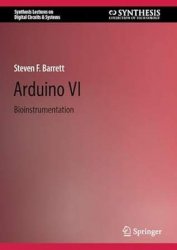 Название: Arduino VI: Bioinstrumentation
Название: Arduino VI: BioinstrumentationАвтор: Steven F. Barrett
Издательство: Springer
Год: 2024
Страниц: 307
Язык: английский
Формат: pdf (true)
Размер: 10.2 MB
This book is about the Arduino microcontroller and the Arduino concept. The visionary Arduino team represented a new innovation in microcontroller hardware in 2005, the concept of open source hardware, making a broad range of computing accessible for all. This book, “Arduino VI: Bioinstrumentation,” is an accessible primer on bioinstrumentation for those without a deep instrumentation background. An understanding of basic circuit theory is an appropriate prerequisite for the book. The three main goals for the book are: explore accessible Arduino microcontroller programming and interfacing concepts; investigate the source and measurement of biomedical signals; and develop skills to design and implement biomedical instrumentation.
Most microcontrollers are programmed with some variant of the C programming language. The C programming language provides a nice balance between the programmer’s control of the microcontroller hardware and time efficiency in program writing. As an alternative, the Arduino Development Environment (ADE) provides a user–friendly interface to quickly develop a program, transform the program to machine code, and then load the machine code into the Arduino processor in several simple steps. We use the ADE through-out the book. You will find the syntax used in the Arduino ADE similar to C programming. A tutorial on C programming is provided in Appendix B.
The book has been divided into three parts to accomplish the book’s goals. The book follows these three steps:
1. Part I: Introduction to Arduino platforms, the Arduino integrated development environment (IDE), Arduino subsystems, programming, and interfacing.
. Chapter 1. Getting started
. Chapter 2. Programming Arduino subsystems
. Chapter 3. Power sources and interfacing
2. Part II: Measuring physiological signals
. Chapter 4. Amplifiers and filtering
. Chapter 5. Biopotentials and electrodes including biomedical signals: electromyogram (EMG), electrocardiogram (ECG), electroencephalogram (EEG)
3. Part III: Developing skills to design and implement medical instrumentation
. Chapter 6. Systems design tools and examples
. Appendix A: Safety
. Appendix B: Programming in C
Part I provides an introduction to the Arduino platform, describes how to program a specific platform using the Arduino IDE, and describes how to properly interface input and output devices. Information is provided on three different Arduino platforms: the Arduino UNO R3, the ATmega2560, and the wearable Arduino LilyPad. Lessons learned can be easily applied to other Arduino platforms.
Part II explores the fundamentals of measuring biomedical signals. The section begins with the fundamentals of signal amplification and filtering using operational amplifiers (op amps), instrumentation amplifiers, and isolation amplifiers for patient safety. Next we explore the origin of biopotentials at the cellular level and how to measure related signals from the surface of the human body using electrodes. We then explore the origins of different types of human-generated biomedical signals and how to measure them.
In Part III, we apply material learned in the first two parts to design a bioinstrumentation system. We review the system design process and tools. We also emphasize the fundamentals of patient and equipment safety in system design. We conclude with a series of detailed examples.
Throughout the book we provide numerous hardware and software examples. As previously mentioned, a tutorial on biomedical safety concepts is readily available in Appendix A and referenced throughout the book. We recommend reading this appendix first (now) and regularly as you progress through the book.
Appendix B provides an introduction to programming in C. You will find the programming syntax used in the Arduino IDE is very similar to C.
Скачать Arduino VI: Bioinstrumentation